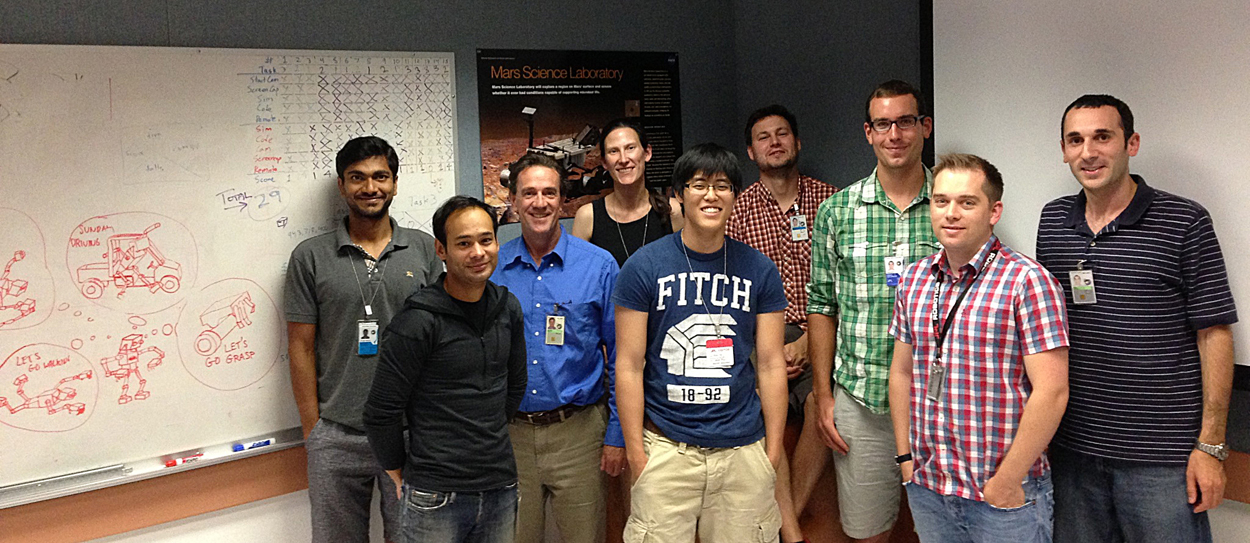
A team comprised of members from UC Santa Barbara, NASA's Jet Propulsion Laboratory, and the California Institute of Technology has been selected to advance to the next round in the highly competitive United States Department of Defense's Defense Advance Research Projects Agency (DARPA) Robotics Challenge.
"We are excited to be advancing to the next round. I think we have a very strong team, but all the other teams still remaining are quite competitive, too," said Katie Byl, assistant professor in the UCSB Department of Electrical and Computer Engineering, and leader of the UCSB component in the challenge, which also included doctoral student researcher Brian Satzinger and graduate student researchers Peter Ha and Howard Hu.
The most recent event, the Virtual Robotics Challenge (VRC), required the team to write software to direct their virtual robot through a series of computer-simulated tasks, assignments related to humanitarian search-and-rescue efforts in times of natural or man-made disasters. Virtual robots were told to drive vehicles, navigate rough terrain, and use tools. The VRC was the first of the three rounds comprising the DARPA Robotic Challenge (DRC). Byl's team was in the "Track B" software-only division of the competition, funded by DARPA.
"Clearly, what we'd like to have is a robot that can perform tasks remotely to allow a human to stay out of harm's way, and to perform as autonomously as possible, in case wireless communication is intermittent," said Byl, whose research emphasis is in legged locomotion in real-world environments, where robots have to overcome challenges, such as difficulties in sensing and navigation over uncertain terrain.
The UCSB/JPL/Caltech team was one of 26 from eight countries competing in the VRC, which took place from June 17-21. A team from the Institute for Human and Machine Cognition in Florida took first place, while Byl's team took fifth place. The top teams will be loaned a highly sophisticated bipedal Atlas robot for the next set of trials in December. Byl's team will be using a JPL-designed four- limbed robot called RoboSimian. Each limb is designed to have equal levels of strength and dexterity. Various combinations of the four limbs can be used for either locomotion or manipulation, depending on the task at hand.
While not the Atlas robot, said Byl, RoboSimian was determined by the team to be the best choice for the DRC, a move that also ensured that team members' efforts would be concentrated on a single project, instead of split between two robots across two teams that would eventually compete against one another. The team will be using the RoboSimian "Clyde" in the December trials, and plans are underway to build a second RoboSimian, nicknamed "Koko" for testing and research at Byl's lab at UCSB.
The DRC is a competition created specifically to develop robots that could function in times of disaster in environments that would be harmful for humans, such as the Fukushima nuclear disaster of 2011. While robots were used for surveillance in Fukushima, nothing could replace humans for tasks like removing debris, turning valves, or climbing ladders, and the competition is one way of bringing the expertise of the worldwide robotics community together. In other future applications, said Byl, powerful, gentle, and dextrous robots could be developed to interact with humans, for instance, by assisting the elderly who wish to remain independent.
"It's hard to believe the first contest with real robots is just a little more than five months away," said Byl. "We'll certainly be busy between now and late December!"
† Top image: The UCSB/JPL/Caltech team, after the Virtual Robotics Challenge: from left to right, Krishna Shankar (Caltech), Max Bajracharya (JPL), Paul Backes (JPL), Katie Byl (UCSB), Peter Ha (UCSB), Nick Hudson (JPL), Brian Satzinger (UCSB), Paul Hebert (JPL), and Jason Reid (JPL). Not in the picture are Howard Hu (UCSB) amd Joel Burdick (Caltech).
Courtesy photo.
Related Links



